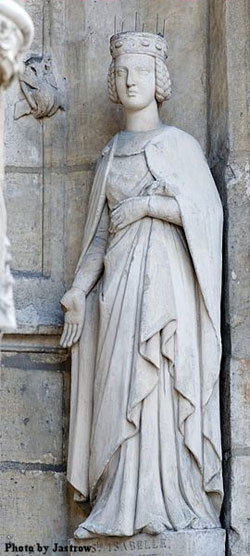
Feastday: February 26
Sister of St. Louis and daughter of King Louis VIII of France and Blanche of Castile, she refused offers of marriage from several noble suitors to continue her life of virginity consecrated to God. She ministered to the sick and the poor, and after the death of her mother, founded the Franciscan Monastery of the Humility of the Blessed Virgin Mary at Longchamps in Paris. She lived there in austerity but never became a nun and refused to become abbess. She died there on February 23, and her cult was approved in 1521.
For other people named Isabella of France, see Isabella of France (disambiguation).Isabelle of France (March 1224 – 23 February 1270) was a French princess, the daughter of Louis VIII of France and Blanche of Castile. She was a younger sister of King Louis IX of France (Saint Louis) and of Alfonso, Count of Poitiers, and an older sister of King Charles I of Sicily. In 1256, she founded the nunnery of Longchamp in part of the Forest of Rouvray (now called the Bois de Boulogne), west of Paris. Isabelle consecrated her virginity and her entire life to God alone. She is honored as a saint by the Franciscan Order. Her feast day is 26 February.
Early life
Isabelle's father died when she was two years old, and it was her mother, Blanche, who oversaw her education. She could read both Latin and the vernacular, and enjoyed tales of chivalry as well as devotional texts. While pursuing the traditional feminine interests such as embroidery, she took special pleasure in working on priestly vestments. As a child, she requested spiritual direction and became even more devoted to the Lord under the guidance of the Franciscans. By the papal bull of 26 May 1254, Pope Innocent IV allowed her to retain some Franciscan friars as her special confessors. She was even more devoted to the Franciscan Order than to her royal brother.
By virtue of the Treaty of Vendôme in March 1227, Isabelle was betrothed to Hugh, eldest son and heir of Hugh X of Lusignan, with the marriage contract being signed on June 1230; however, she refused to celebrate the formal wedding due to her fixed determination to remain a virgin, although she never became a nun. Later, she refused the hand of Conrad IV of Germany, son of Frederick II, Holy Roman Emperor, although pressed to accept by everyone, even by Innocent IV.
Longchamp Abbey
As Isabelle wished to found a community of Sorores minores (Sisters minor), her brother King Louis began in 1255 to acquire the necessary land in the Forest of Rouvray, not far from the Seine, west of Paris. On 10 June 1256, the first stone of the monastic church was laid. Pope Alexander IV gave his sanction on 2 February 1259 to the new Rule, which was composed especially for this monastery by Isabelle along with a team of Franciscan university masters including St. Bonaventure. The community was allowed to hold property. The monastery was named the Convent of the Humility of the Blessed Virgin. In the Rule the nuns were called the Sisters of the Humble Order of Servants of the Most Blessed Virgin Mary. The nuns were subject to the Friars Minor. Some of the first nuns came from the Poor Clare monastery in Reims. A revised version of the Rule was approved by Pope Urban IV on 27 July 1263, which granted preferred name of Sorores minores inclusae, or Enclosed Sisters minor, for the nuns of Longchamp.
Isabelle never joined the community herself, but did live there in a room separate from the nuns' cells. Isabelle refused to become abbess, which allowed her to retain her wealth and resources, so she could support her abbey and continue to give to the poor. She kept a discipline of silence for most of her day.
Death
Isabelle died at Longchamp on 23 February 1270, and was buried in the abbey church. After nine days her body was exhumed; according to the religious legend, it showed no signs of decay, and many miracles were said to have been wrought at her grave. In 1521 Pope Leo X allowed the abbey to celebrate her feast day with a special Office. On 4 June 1637, a second exhumation took place. On 25 January 1688, the nuns obtained permission to celebrate her feast with an octave, and in 1696 the celebration of the feast on 31 August was permitted to the whole Franciscan Order by Pope Innocent XII.
Longchamp Abbey was suppressed in the French Revolution. In 1794 the empty building was offered for sale, but, as no one wished to purchase it, it was destroyed. In 1857 the remaining walls were pulled down, except for one tower, and the land was incorporated into the Bois de Boulogne.
Ancestry
| This section does not cite any sources. (December 2020) |
| Ancestors of Isabelle of France (saint) | |||||||||||||||||||||||||||||||||||||||||||||||||||||||||||||||||||||||||||||||||||||||||||||||||||||||||||||||||||||||||||||||||||||||||||||||||||||||||||||||||||||||||||||||||||||||||||||||||||||||||||||||||||||||||||||||||||||||||||||||||||||||||||||||||||||||||||||||||||||||||
|---|---|---|---|---|---|---|---|---|---|---|---|---|---|---|---|---|---|---|---|---|---|---|---|---|---|---|---|---|---|---|---|---|---|---|---|---|---|---|---|---|---|---|---|---|---|---|---|---|---|---|---|---|---|---|---|---|---|---|---|---|---|---|---|---|---|---|---|---|---|---|---|---|---|---|---|---|---|---|---|---|---|---|---|---|---|---|---|---|---|---|---|---|---|---|---|---|---|---|---|---|---|---|---|---|---|---|---|---|---|---|---|---|---|---|---|---|---|---|---|---|---|---|---|---|---|---|---|---|---|---|---|---|---|---|---|---|---|---|---|---|---|---|---|---|---|---|---|---|---|---|---|---|---|---|---|---|---|---|---|---|---|---|---|---|---|---|---|---|---|---|---|---|---|---|---|---|---|---|---|---|---|---|---|---|---|---|---|---|---|---|---|---|---|---|---|---|---|---|---|---|---|---|---|---|---|---|---|---|---|---|---|---|---|---|---|---|---|---|---|---|---|---|---|---|---|---|---|---|---|---|---|---|---|---|---|---|---|---|---|---|---|---|---|---|---|---|---|---|---|---|---|---|---|---|---|---|---|---|---|---|---|---|---|---|---|---|---|---|---|---|---|---|---|---|---|---|---|---|---|---|---|
| |||||||||||||||||||||||||||||||||||||||||||||||||||||||||||||||||||||||||||||||||||||||||||||||||||||||||||||||||||||||||||||||||||||||||||||||||||||||||||||||||||||||||||||||||||||||||||||||||||||||||||||||||||||||||||||||||||||||||||||||||||||||||||||||||||||||||||||||||||||||||





